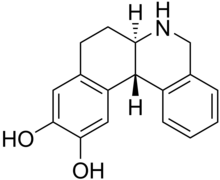Dihydrexidine
 | |
| Clinical data | |
|---|---|
| ATC code |
|
| Identifiers | |
| |
| CAS Number | |
| PubChem CID | |
| ChemSpider | |
| UNII | |
| ChEMBL | |
| CompTox Dashboard (EPA) | |
| Chemical and physical data | |
| Formula | C17H17NO2 |
| Molar mass | 267.328 g·mol−1 |
| 3D model (JSmol) | |
| |
| |
| | |
Dihydrexidine (DAR-0100) is a moderately selective full agonist at the dopamine D1 and D5 receptors.[1] It has approximately 10-fold selectivity for D1 and D5 over the D2 receptor.[2] Although dihydrexidine has some affinity for the D2 receptor, it has functionally selective (highly biased) D2 signaling,[3] thereby explaining why it lacks D2 agonist behavioral qualities.[4]
Dihydrexidine has shown impressive antiparkinson effects in the MPTP-primate model,[5] and has been investigated for the treatment of Parkinson's disease.[6] In an early clinical trial the drug was given intravenously and led to profound hypotension so development was halted.[7] The drug was resurrected when it was shown that smaller subcutaneous doses were safe.[8] This led to a pilot study in schizophrenia[9] and current clinical trials to assess its efficacy in improving the cognitive and working memory deficits in schizophrenia and schizotypal disorder.
There have been several reviews of relevance to the compound.[10][11][12]
References
- ^ Lovenberg TW, Brewster WK, Mottola DM, Lee RC, Riggs RM, Nichols DE, Lewis MH, Mailman RB (1989). "Dihydrexidine, a novel selective high potency full dopamine D-1 receptor agonist". Eur J Pharmacol. 166 (1): 111–113. doi:10.1016/0014-2999(89)90690-0. PMID 2572425.
- ^ Mottola DM, Brewster WK, Cook LL, Nichols DE, Mailman RB (1992). "Dihydrexidine, a novel full efficacy D1 dopamine receptor agonist". J Pharmacol Exp Ther. 262 (1): 383–393. PMID 1352553.
- ^ Kilts, JD.; et al. (2002). "Functional selectivity of dopamine receptor agonists. II. Actions of dihydrexidine in D2L receptor-transfected MN9D cells and pituitary lactotrophs". J Pharmacol Exp Ther. 301 (3): 1179–89. doi:10.1124/jpet.301.3.1179. PMID 12023553.
- ^ Darney KJ Jr, Lewis MH, Brewster WK, Nichols DE, Mailman RB (1991). "Behavioral effects in the rat of dihydrexidine, a high-potency, full-efficacy D1 dopamine receptor agonist". Neuropsychopharmacology. 5 (3): 187–195. PMID 1684499.
- ^ Taylor JR, Lawrence MS, Redmond DE Jr, Elsworth JD, Roth RH, Nichols DE, Mailman RB (1991). "Dihydrexidine, a full dopamine D1 agonist, reduces MPTP-induced parkinsonism in monkeys". Eur J Pharmacol. 199 (3): 389–391. doi:10.1016/0014-2999(91)90508-N. PMID 1680717.
- ^ Mailman RB, Nichols DE (1998). "Dopamine D1 receptor agonists as antiparkinson drugs". Trends Pharmacol. Sci. 19 (7): 255–256. doi:10.1016/S0165-6147(98)01219-X. PMID 9703756.
- ^ Blanchet PJ, Fang J, Gillespie M, Sabounjian L, Locke KW, Gammans R, Mouradian MM, Chase TN (1998). "Effects of the full dopamine D1 receptor agonist dihydrexidine in Parkinson's disease". Clin. Neuropharmacol. 21 (6): 339–343. PMID 9844789.
- ^ George MS, Molnar CE, Grenesko EL, Anderson B, Mu Q, Johnson K, Nahas Z, Knable M, Fernandes P, Juncos J, Huang X, Nichols DE, Mailman RB (2007). "A single 20 mg dose of dihydrexidine (DAR-0100), a full dopamine D1 agonist, is safe and tolerated in patients with schizophrenia". Schizophr. Res. 93 (1–3): 42–50. doi:10.1016/j.schres.2007.03.011. PMID 17467956. S2CID 31375175.
- ^ Mu Q, Johnson K, Morgan PS, Grenesko EL, Molnar CE, Anderson B, Nahas Z, Kozel FA, Kose S, Knable M, Fernandes P, Nichols DE, Mailman RB, George MS (2007). "A single 20 mg dose of the full D1 dopamine agonist dihydrexidine (DAR-0100) increases prefrontal perfusion in schizophrenia". Schizophr. Res. 94 (1–3): 332–341. doi:10.1016/j.schres.2007.03.033. PMID 17596915. S2CID 25497605.
- ^ Mailman R, Huang X, Nichols DE (2001). "Parkinson's disease and D1 dopamine receptors". Current Opinion in Investigational Drugs. 2 (11): 1582–1591. PMID 11763161.
- ^ Salmi P, Isacson R, Kull B (2004). "Dihydrexidine--the first full dopamine D1 receptor agonist". CNS Drug Rev. 10 (3): 230–242. doi:10.1111/j.1527-3458.2004.tb00024.x. PMC 6741759. PMID 15492773.
- ^ Zhang J, Xiong B, Zhen X, Zhang A (2009). "Dopamine D1 receptor ligands: where are we now and where are we going". Med Res Rev. 29 (2): 272–294. doi:10.1002/med.20130. PMID 18642350. S2CID 25334596.
- Articles with short description
- Short description matches Wikidata
- Drugs not assigned an ATC code
- Articles with changed ChemSpider identifier
- Articles with changed EBI identifier
- Articles with changed InChI identifier
- Chemical pages without DrugBank identifier
- Articles without KEGG source
- Drugs with no legal status
- Drugboxes which contain changes to verified fields
- Drugboxes which contain changes to watched fields
- D1-receptor agonists
- D2-receptor agonists
- D5 receptor agonists
- Catechols
- Biased ligands
- All stub articles
- Antihypertensive agent stubs